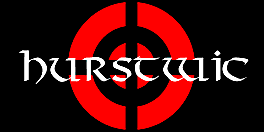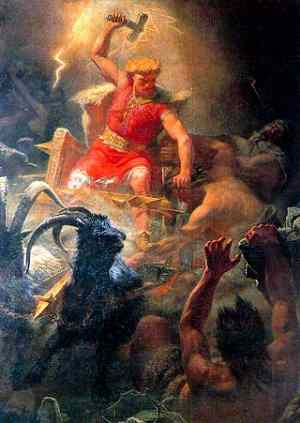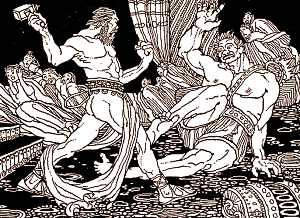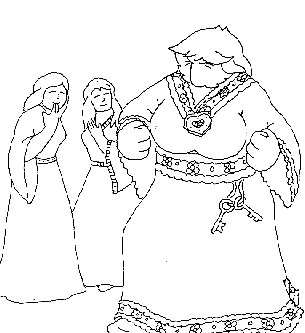
|

|
Þór
 Þór
(Thor) is the son of Óðin and is god of thunder, and
of the household. Powerful and virile, he is a protector and the guardian of gods and men alike. Þór's
hammer Mjöllnir is the main defense against
the giants, enemies of the gods. He is the patron of the karls, the common freemen. Of all the
gods, he is the most
beloved and respected by the sons of men. Since he controls the
weather, his favor is frequently requested by sailors and travelers.
Þór
(Thor) is the son of Óðin and is god of thunder, and
of the household. Powerful and virile, he is a protector and the guardian of gods and men alike. Þór's
hammer Mjöllnir is the main defense against
the giants, enemies of the gods. He is the patron of the karls, the common freemen. Of all the
gods, he is the most
beloved and respected by the sons of men. Since he controls the
weather, his favor is frequently requested by sailors and travelers.
Þór is quick to anger. His usual response to any problem is to use Mjöllnir to smash the offender's skull down between his shoulders. To a Norseman, the sound of thunder was reassurance that Þór was on the job, protecting the worlds from enemies.
Þór is thick-skulled and susceptible to ridicule; in a battle of wits, he usually comes out second best. An example occurs in Hárbarðsljóð, in which Óðin, disguised as Hárbarð, and Þór engage in a flyting, the traditional Norse exchange of insults. The winner is the one who best proves his courage and manhood while demonstrating the cowardice, laziness, and effeminacy of his opponent. Þór is so outclassed in this exchange that he doesn't even realize he's lost the flyting.
Perhaps the funniest of the Norse myths is Þrymskviða, which tells how the giant Þrym stole Mjöllnir and refused to return it unless Freyja (the goddess of love, and the sister of Freyr) was given to be his bride. Freyja, naturally, refused. The gods were desperate to recover Mjöllnir. Heimdall concocted a plan: Þór would disguise himself as Freyja and travel to Þrym's hall to recover the hammer. Þór protested, "The Æsir will think me perverted."
His protests were overruled. The gods dressed Þór in a bridal veil and a becoming dress. To the outfit, they added broaches, and they hung a bunch of keys from his waist. Their eye for detail only added to Þór's misery, while delighting the assembled gods. Þór's protests were ignored as the gods crowned their efforts by placing a head-dress on Þór's head.
Taking Loki to serve as bridesmaid, Þór traveled
to Þrym's hall in Jötenheim, land of the giants. Þrym
was in a frenzy making preparations once he saw that "Freyja"
was arriving. That evening, at the feast, Þrym was suspicious
of "Freyja's" enormous capacity for food (an entire
oxen) and drink (three casks of mead), as well as of her blazing
eyes, but her "bridesmaid" explained that it was due
to "Freyja's" wild anticipation for her wedding night.
 When
the hammer Mjöllnir was brought out to hallow the marriage, Þór
snatched it and used it to crush the skull of Þrym and to
kill all the other giants in the hall.
When
the hammer Mjöllnir was brought out to hallow the marriage, Þór
snatched it and used it to crush the skull of Þrym and to
kill all the other giants in the hall.
I can't do justice to this story of Þór and Þrym in two paragraphs. It is beautifully understated deadpan comedy and is considered to rank with the best ballads in any language. It also highlights a significant aspect of an Norseman's view of the gods: rather than being fearsome deities, the Norse gods and goddesses were comrades with whom it was permissible to be familiar.
 Beyond
the burlesque humor in this story, more subtle humor exists
on another level. The unknown author of this work has quoted from
other stories that would have been familiar to his audience. So,
for example, as the author describes the ludicrous approach of
Þór to the giant's castle for the wedding feast,
he uses the heroic language and sounds and rhythms from Eiríksmál
in which the hero Eiríkr blóðøx (Erik
Bloodaxe) approaches Óðin sitting in Valhöll.
The ironic contrast would surely have enhanced the comic aspect
of the situation for a Norse audience.
Beyond
the burlesque humor in this story, more subtle humor exists
on another level. The unknown author of this work has quoted from
other stories that would have been familiar to his audience. So,
for example, as the author describes the ludicrous approach of
Þór to the giant's castle for the wedding feast,
he uses the heroic language and sounds and rhythms from Eiríksmál
in which the hero Eiríkr blóðøx (Erik
Bloodaxe) approaches Óðin sitting in Valhöll.
The ironic contrast would surely have enhanced the comic aspect
of the situation for a Norse audience.
A children's edition of Þrymskviða
was published in Iceland in 1980, illustrated by Haraldur Gušbergsson. The
pictures perfectly capture the humor of the story and have delighted numerous
children to whom I've read the poem. Harald's
sketch of Þór being dressed for the wedding is shown to the right.
|
|
©1999-2025 William R. Short |